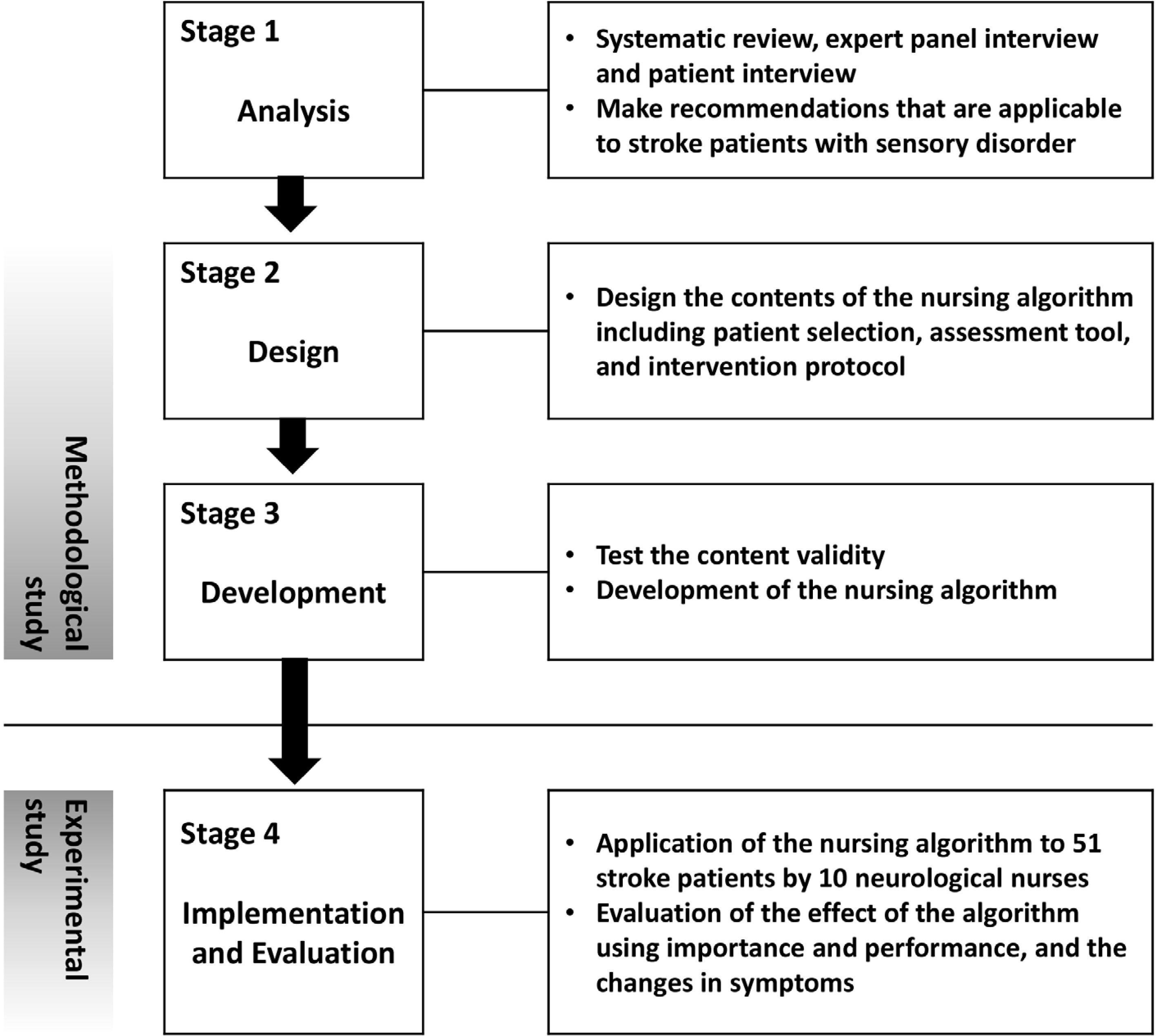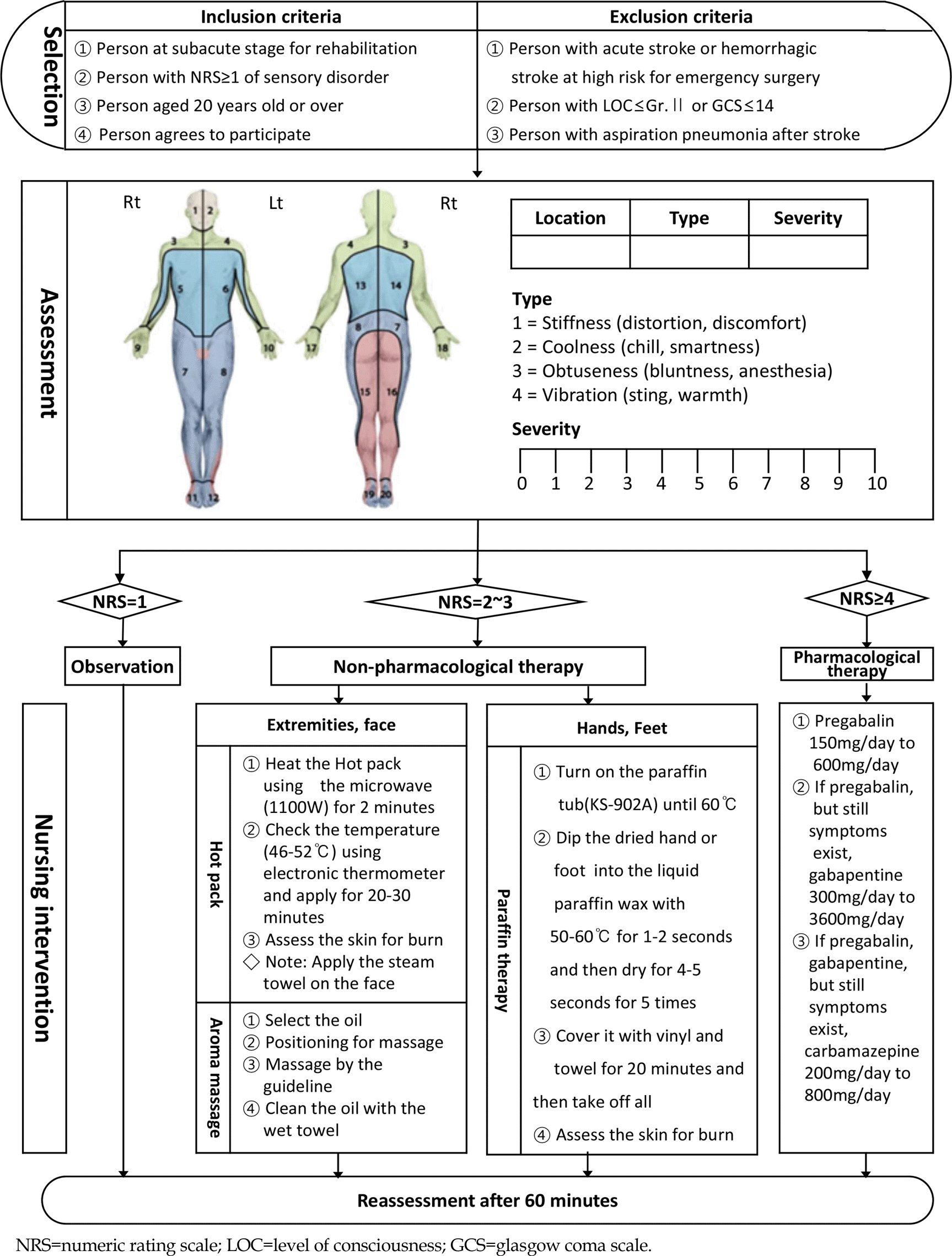Abstract
Purpose
Although post-stroke sensory disorder is different from post-stroke pain, it is often considered as central pain or overlooked in the clinical field. The purposes of this study were to develop the nursing algorithm for stroke patients with sensory disorder and examine its effect.
Methods
The study used a methodological design to develop the nursing algorithm and a pretest-posttest design to examine its effect in stroke patients. The algorithm was developed through the ADDIE model (Analysis, Design, Development, Implementation, and Evaluation) using systematic review, expert panel interview, and patient interview. The algorithm was applied to 51 ischemic stroke patients experi-encing sensory disorder at subacute stage by 10 nurses in a university hospital in Seoul city, Korea.
Results
The contents of the algorithm included inclusion and exclusion criteria for relevant patients, assessment tool developed in this study, and the intervention (non-pharmacological and pharmacological) process based on the assessment results. The assessment tool and the intervention process had acceptable inter-rater reliability with Cohen's Kappa .82 and .94, respectively. The scores of sensory disorder decreased from 2.71 to 0.51 with the algorithm application in 51 patients.
Conclusion
The nursing algorithm for sensory disorder in stroke patients improved the symptoms and can be used conveniently by clinical nurses. Using this algorithm, nurses can provide relevant care for stroke patients with stiff, cool, obtuse, or vibrating sensors that cause insomnia, anorexia, and physical functional decline.
REFERENCES
1. Statistics Korea. Cause of death statistics 2015 [Internet]. Seoul: Statistics Korea;2016. [cited 2018 January 1]. Available from:. http://kostat.go.kr/portal/korea/kor_nw/2/6/2/index.-board?bmode=read&bSeq=&aSeq=356345&pageNo=1&row-Num=10&navCount=10&currPg=&sTarget=title&sTxt=.
2. Kim KJ, Heo M, Chun IA, Jun HJ, Lee JS, Jegal H, et al. The relationship between stroke and quality of life in Korean adults: based on the 2010 Korean community health survey. Journal of Physical Therapy Science. 2015; 27(1):309–12. https://doi.org/10.1589/jpts.27.309.

3. Kessner SS, Bingel U, Thomalla G. Somatosensory deficits after stroke: a scoping review. Topics in Stroke Rehabilitation. 2016; 23(2):136–46. https://doi.org/10.1080/10749357.2015.1116822.

4. Krause T, Asseyer S, Geisler F, Fiebach JB, Oeltjenbruns J, Kopf A, et al. Chronic sensory stroke with and without central pain is associated with bilaterally distributed sensory abnormal-ities as detected by quantitative sensory testing. Pain. 2016; 157(1):194–202. https://doi.org/10.1097/j.pain.0000000000000354.

5. Wutzke CJ, Mercer VS, Lewek MD. Influence of lower extremity sensory function on locomotor adaptation following stroke: a review. Topic in Stroke Rehabilitation. 2013; 20(3):233–40. https://doi.org/10.1310/tsr2003-233.

6. Meyer S, Kessner SS, Cheng B, Bönstrup M, Schulz R, Hummel FC, et al. Voxel-based lesion-symptom mapping of stroke lesions underlying somatosensory deficits. Neuroimage: Clinical. 2015; 10:257–66. https://doi.org/10.1016/j.nicl.2015.12.005.

7. Korean Neurological Association. Textbook of neurology. Seoul: Beommun Education;2012. p. 650–701.
8. Bolognini N, Russo C, Edwards DJ. The sensory side of post-stroke motor rehabilitation. Restorative Neurology and Neuro-science. 2016; 34(4):571–86. https://doi.org/10.3233/RNN-150606.

9. Rho H, Kim K, Choi M, Kim JS. Effects of aroma foot relaxation massage on subjective pain and physiological indexes of patients with cerebral apoplexy. Journal of the Korean Data Analysis Society. 2010; 12(6):3087–101.
10. Oh HS, Seo WS. A comprehensive review of central post-stroke pain. Pain Management Nursing. 2015; 16(5):804–18. https://doi.org/10.1016/j.pmn.2015.03.002.

11. Lee JS, Seo NS. Effects of the meridian massage on the hand edema, activities of daily living, and depression in stroke patients. Journal of Korean Academy of Adult Nursing. 2010; 22(2):171–81.
12. Oh DW, Park HJ, Sim SM. Sensory training for individuals with post-stroke hemiparesis: fundamental basis of stroke rehabilitation. Korean Journal of Neuromuscular Rehabilitation. 2015; 5(1):45–68.
13. Kim KS, Yoon EJ, Kim SY, Kim OS, So HS, Lee MS, et al. Adult nursing II. 8th ed. Seoul: Soomoonsa;2016. p. 1214.
14. Lee J. Smart nursing research for self-directed action learning. Seoul: DaehanNarae;2018. p. 70.
15. Morrison GR, Ross SM, Kemp JE, Kalman HK. Designing effective instruction. 6th ed.Hoboken NJ: John Wiley & Sons;2010. p. 76–105.
16. National Cancer Center: Cancer pain management guideline [Internet]. Goyang-si: National Cancer Center;2015. [cited 2016 August 30]. Available from:. https://www.emc.ac.kr/include/download.jsp?board_sequence=1,10194.
17. Mohammadpour A, Mohammadian B, Basiri Moghadam M, Nematollahi MR. The effects of topical heat therapy on chest pain in patients with acute coronary syndrome: a randomised double-blind placebo-controlled clinical trial. Journal of Clinical Nursing. 2014; 23(23-24):3460–7. https://doi.org/10.1111/jocn.12595.

18. Sung MH, Lee MH, Song GS, Jun EM. The effects of foot reflex-ology massage on the central pain, fatigue and sleep in stroke patients. Journal of Korean Clinical Nursing Research. 2011; 17(1):46–56.
19. Buckle J. Clinical aromatherapy: essential oils in healthcare. London: Churchill Livingstone;2014. p. 252–320.
20. Chen TH, Tung TH, Chen PS, Wang SH, Chao CM, Hsiung NH, et al. The clinical effects of aromatherapy massage on reducing pain for the cancer patients: metaanalysis of randomized controlled trials. Evidence Based Complementary and Alternative Medicine. 2016; 2016:914974. https://doi.org/10.1155/2016/9147974.

21. Hong SJ, Kim EH. Effects of aroma head and neck massage on sleep disturbance and problematic behaviors, depression, blood serotonin, blood cortisol, and the vital signs on elders with dementia. Crisisonomy. 2014; 10(9):75–92.
22. Hashemi SH, Hajbagheri A, Aghajani M. The effect of massage with lavender oil on restless leg syndrome in hemodialysis patients: a randomized controlled trial. Nursing and Midwifery Studies. 2015; 4(4):e29617. https://doi.org/10.17795/nmsjournal29617.

23. Kim BI, Hong RH, Lee SN, Han EH, Lee HY, Kim YJ, et al. Aromatherapy massage. Seoul: Kwangmoonkag;2004. p. 25–113.
24. Lee SK, Oh JS. The effect of paraffin bath and contrast bath on the cosmetologists of the carpal tunnel syndrome. Asian Journal of Beauty and Cosmetology. 2010; 8(2):97–106.
25. Kim JS. Pharmacological management of central post-stroke pain: a practical guide. CNS Drugs. 2014; 28(9):787–97. https://doi.org/10.1007/s40263-014-0194-y.

26. Mulla SM, Wang L, Khokhar R, Izhar Z, Agarwal A, Couban R, et al. Management of central poststroke pain: systematic review of randomized controlled trials. Stroke. 2015; 46(10):2853–60. https://doi.org/10.1161/STROKEAHA.115.010259.
27. Bowsher D. Central pain: clinical and physiological characteristics. Journal of Neurology, Neurosurgery and Psychiatry. 1996; 61(1):62–9.

28. Kita K, Otaka Y, Takeda K, Sakata S, Ushiba J, Kondo K, et al. A pilot study of sensory feedback by transcutaneous electrical nerve stimulation to improve manipulation deficit caused by severe sensory loss after stroke. Journal of Neuroengineering and Rehabilitation. 2013; 10(55):1–16. https://doi.org/10.1186/1743-0003-10-55.

29. Boo EH, Ahn GH, Hong NS, Son JI, Park MH, Kim JN, et al. Effects of the comprehensive nursing services project and improving plans. National Health Insurance Service Report. Ilsan, Gyunggido: National Health Insurance Service Ilsan Hospital;2015 December. Report No.: 2015-20-029.
Table 1.
General Characteristics of Participants (N=61)
Table 2.
Differences of Means between Importance and Performance (N=10)




 PDF
PDF ePub
ePub Citation
Citation Print
Print




 XML Download
XML Download